Essay: How Media Portrays Indigenous People in Canada
VerifiedAdded on 2023/06/01
|7
|1838
|475
Essay
AI Summary
This essay examines the media's portrayal of Indigenous communities in Canada, highlighting the discrepancies between reality and representation. It discusses how historical narratives, stereotypes, and a focus on profit-driven content contribute to the underrepresentation and misrepresentation of Indigenous issues. The essay also explores the role of media in perpetuating negative stereotypes, influencing public perception, and impacting the self-esteem of Indigenous people. It references various sources, including academic articles and books, to support its arguments and emphasizes the need for more accurate and respectful representation of Indigenous culture, history, and contemporary challenges. The conclusion advocates for bridging the gap between communities through responsible media practices and addressing real-life issues faced by Indigenous populations.
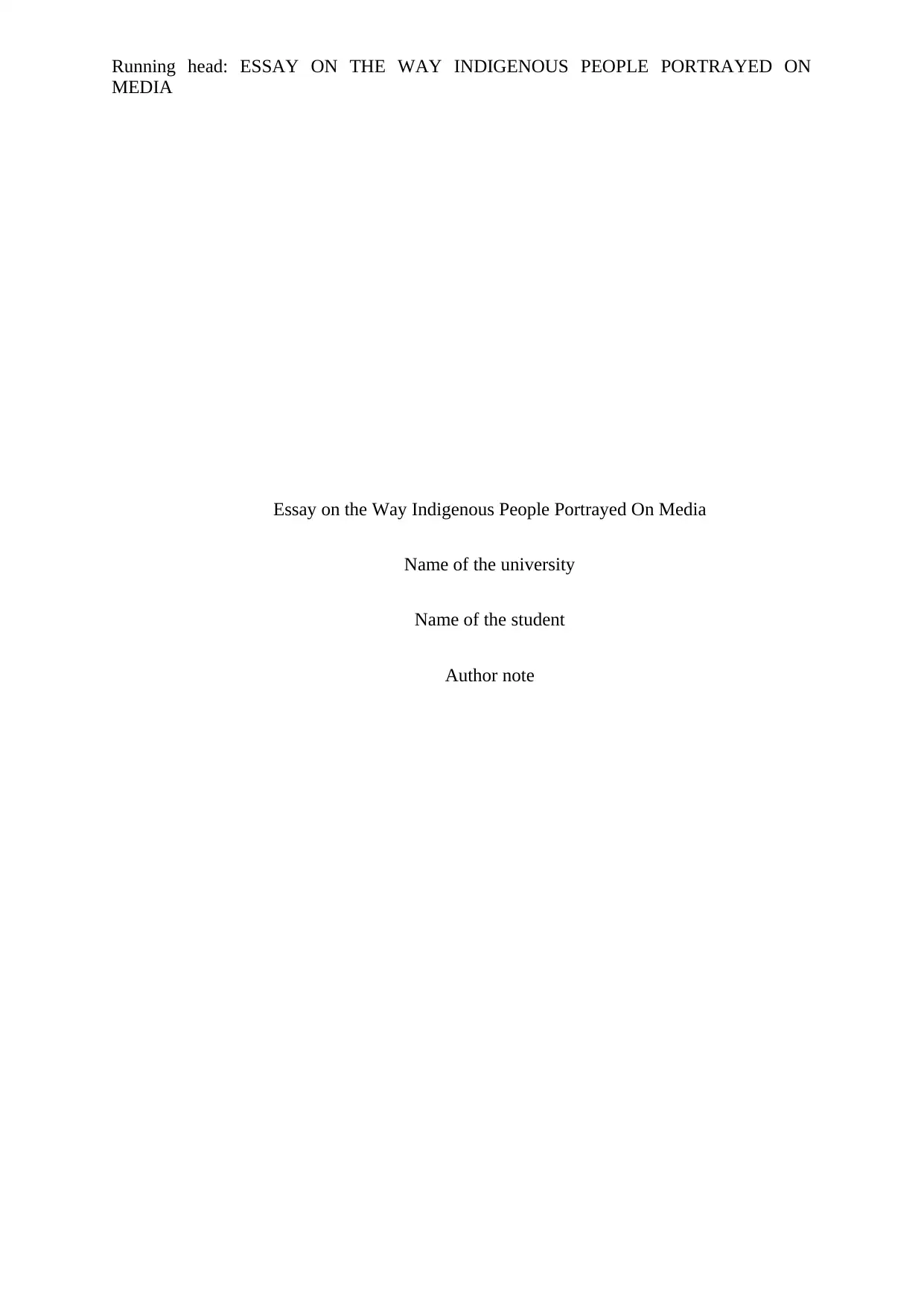
Running head: ESSAY ON THE WAY INDIGENOUS PEOPLE PORTRAYED ON
MEDIA
Essay on the Way Indigenous People Portrayed On Media
Name of the university
Name of the student
Author note
MEDIA
Essay on the Way Indigenous People Portrayed On Media
Name of the university
Name of the student
Author note
Paraphrase This Document
Need a fresh take? Get an instant paraphrase of this document with our AI Paraphraser
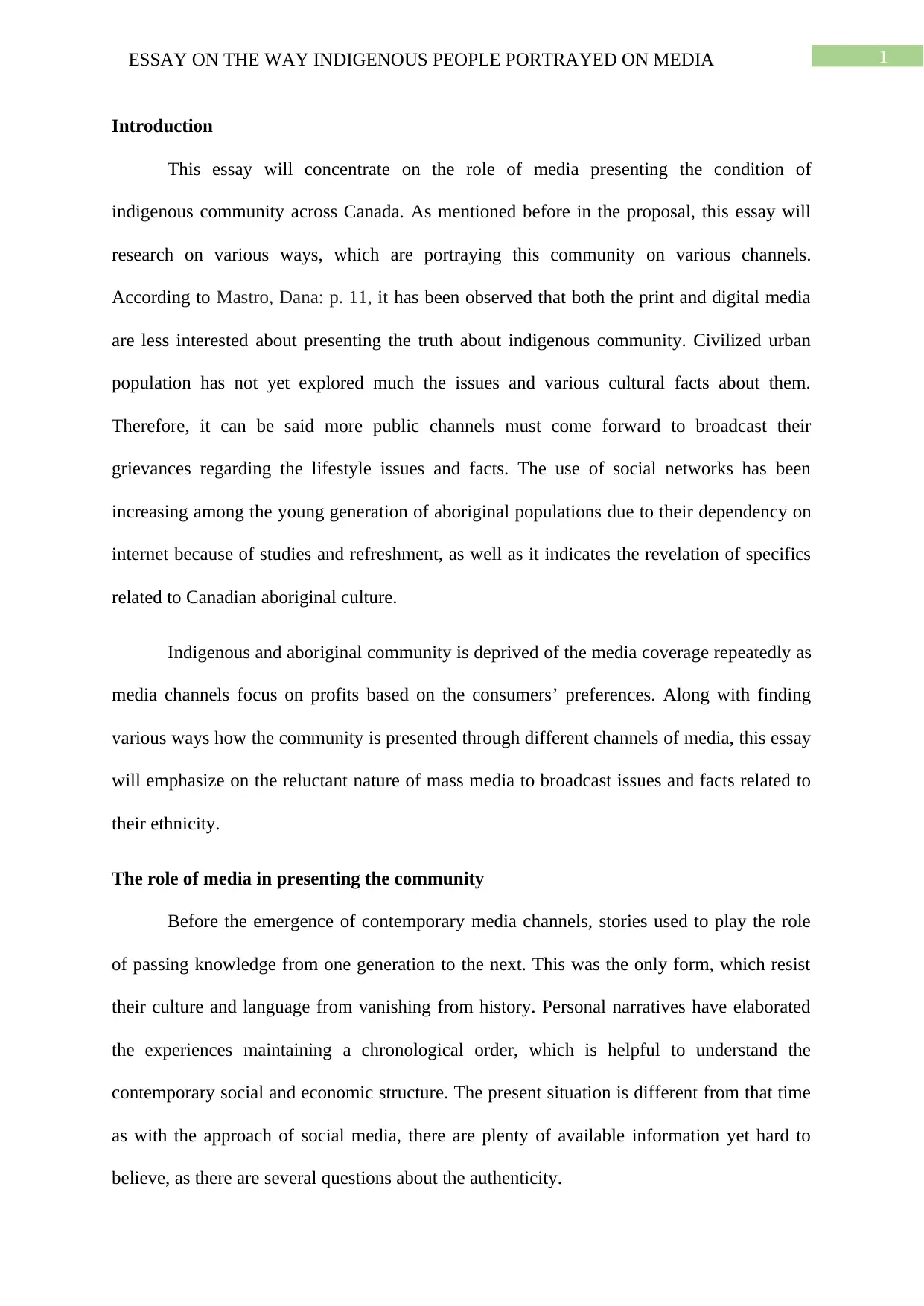
1ESSAY ON THE WAY INDIGENOUS PEOPLE PORTRAYED ON MEDIA
Introduction
This essay will concentrate on the role of media presenting the condition of
indigenous community across Canada. As mentioned before in the proposal, this essay will
research on various ways, which are portraying this community on various channels.
According to Mastro, Dana: p. 11, it has been observed that both the print and digital media
are less interested about presenting the truth about indigenous community. Civilized urban
population has not yet explored much the issues and various cultural facts about them.
Therefore, it can be said more public channels must come forward to broadcast their
grievances regarding the lifestyle issues and facts. The use of social networks has been
increasing among the young generation of aboriginal populations due to their dependency on
internet because of studies and refreshment, as well as it indicates the revelation of specifics
related to Canadian aboriginal culture.
Indigenous and aboriginal community is deprived of the media coverage repeatedly as
media channels focus on profits based on the consumers’ preferences. Along with finding
various ways how the community is presented through different channels of media, this essay
will emphasize on the reluctant nature of mass media to broadcast issues and facts related to
their ethnicity.
The role of media in presenting the community
Before the emergence of contemporary media channels, stories used to play the role
of passing knowledge from one generation to the next. This was the only form, which resist
their culture and language from vanishing from history. Personal narratives have elaborated
the experiences maintaining a chronological order, which is helpful to understand the
contemporary social and economic structure. The present situation is different from that time
as with the approach of social media, there are plenty of available information yet hard to
believe, as there are several questions about the authenticity.
Introduction
This essay will concentrate on the role of media presenting the condition of
indigenous community across Canada. As mentioned before in the proposal, this essay will
research on various ways, which are portraying this community on various channels.
According to Mastro, Dana: p. 11, it has been observed that both the print and digital media
are less interested about presenting the truth about indigenous community. Civilized urban
population has not yet explored much the issues and various cultural facts about them.
Therefore, it can be said more public channels must come forward to broadcast their
grievances regarding the lifestyle issues and facts. The use of social networks has been
increasing among the young generation of aboriginal populations due to their dependency on
internet because of studies and refreshment, as well as it indicates the revelation of specifics
related to Canadian aboriginal culture.
Indigenous and aboriginal community is deprived of the media coverage repeatedly as
media channels focus on profits based on the consumers’ preferences. Along with finding
various ways how the community is presented through different channels of media, this essay
will emphasize on the reluctant nature of mass media to broadcast issues and facts related to
their ethnicity.
The role of media in presenting the community
Before the emergence of contemporary media channels, stories used to play the role
of passing knowledge from one generation to the next. This was the only form, which resist
their culture and language from vanishing from history. Personal narratives have elaborated
the experiences maintaining a chronological order, which is helpful to understand the
contemporary social and economic structure. The present situation is different from that time
as with the approach of social media, there are plenty of available information yet hard to
believe, as there are several questions about the authenticity.
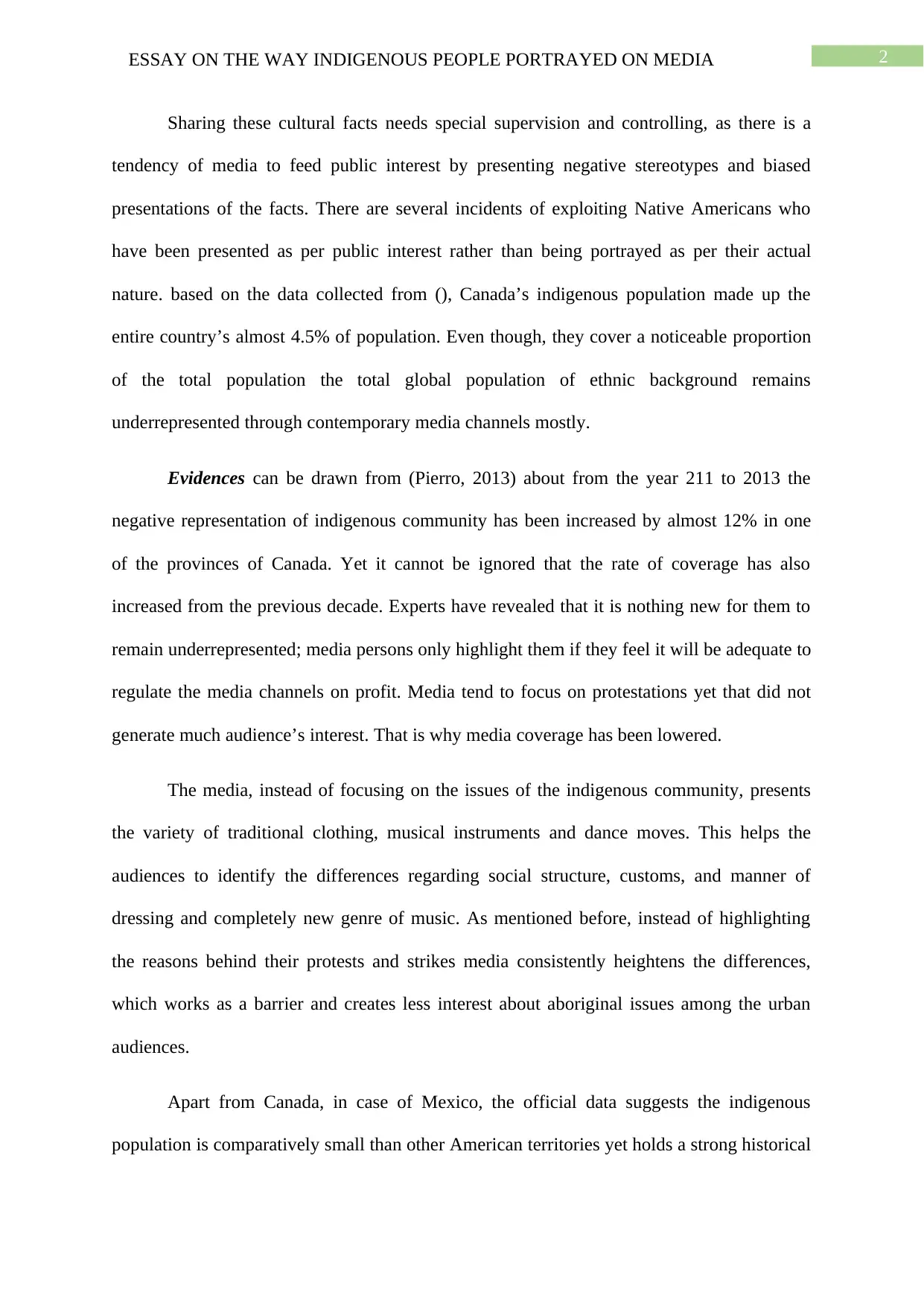
2ESSAY ON THE WAY INDIGENOUS PEOPLE PORTRAYED ON MEDIA
Sharing these cultural facts needs special supervision and controlling, as there is a
tendency of media to feed public interest by presenting negative stereotypes and biased
presentations of the facts. There are several incidents of exploiting Native Americans who
have been presented as per public interest rather than being portrayed as per their actual
nature. based on the data collected from (), Canada’s indigenous population made up the
entire country’s almost 4.5% of population. Even though, they cover a noticeable proportion
of the total population the total global population of ethnic background remains
underrepresented through contemporary media channels mostly.
Evidences can be drawn from (Pierro, 2013) about from the year 211 to 2013 the
negative representation of indigenous community has been increased by almost 12% in one
of the provinces of Canada. Yet it cannot be ignored that the rate of coverage has also
increased from the previous decade. Experts have revealed that it is nothing new for them to
remain underrepresented; media persons only highlight them if they feel it will be adequate to
regulate the media channels on profit. Media tend to focus on protestations yet that did not
generate much audience’s interest. That is why media coverage has been lowered.
The media, instead of focusing on the issues of the indigenous community, presents
the variety of traditional clothing, musical instruments and dance moves. This helps the
audiences to identify the differences regarding social structure, customs, and manner of
dressing and completely new genre of music. As mentioned before, instead of highlighting
the reasons behind their protests and strikes media consistently heightens the differences,
which works as a barrier and creates less interest about aboriginal issues among the urban
audiences.
Apart from Canada, in case of Mexico, the official data suggests the indigenous
population is comparatively small than other American territories yet holds a strong historical
Sharing these cultural facts needs special supervision and controlling, as there is a
tendency of media to feed public interest by presenting negative stereotypes and biased
presentations of the facts. There are several incidents of exploiting Native Americans who
have been presented as per public interest rather than being portrayed as per their actual
nature. based on the data collected from (), Canada’s indigenous population made up the
entire country’s almost 4.5% of population. Even though, they cover a noticeable proportion
of the total population the total global population of ethnic background remains
underrepresented through contemporary media channels mostly.
Evidences can be drawn from (Pierro, 2013) about from the year 211 to 2013 the
negative representation of indigenous community has been increased by almost 12% in one
of the provinces of Canada. Yet it cannot be ignored that the rate of coverage has also
increased from the previous decade. Experts have revealed that it is nothing new for them to
remain underrepresented; media persons only highlight them if they feel it will be adequate to
regulate the media channels on profit. Media tend to focus on protestations yet that did not
generate much audience’s interest. That is why media coverage has been lowered.
The media, instead of focusing on the issues of the indigenous community, presents
the variety of traditional clothing, musical instruments and dance moves. This helps the
audiences to identify the differences regarding social structure, customs, and manner of
dressing and completely new genre of music. As mentioned before, instead of highlighting
the reasons behind their protests and strikes media consistently heightens the differences,
which works as a barrier and creates less interest about aboriginal issues among the urban
audiences.
Apart from Canada, in case of Mexico, the official data suggests the indigenous
population is comparatively small than other American territories yet holds a strong historical
⊘ This is a preview!⊘
Do you want full access?
Subscribe today to unlock all pages.

Trusted by 1+ million students worldwide
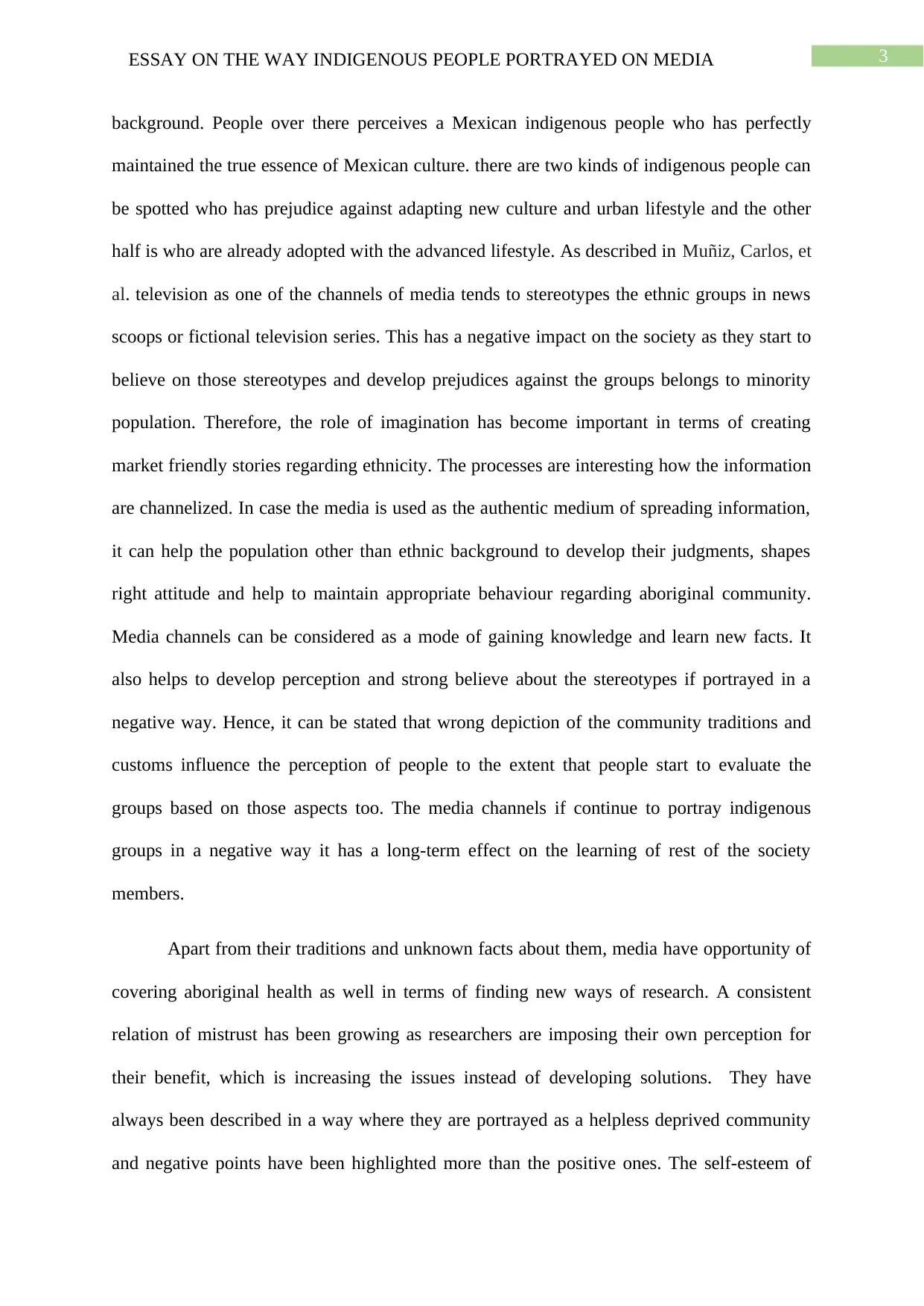
3ESSAY ON THE WAY INDIGENOUS PEOPLE PORTRAYED ON MEDIA
background. People over there perceives a Mexican indigenous people who has perfectly
maintained the true essence of Mexican culture. there are two kinds of indigenous people can
be spotted who has prejudice against adapting new culture and urban lifestyle and the other
half is who are already adopted with the advanced lifestyle. As described in Muñiz, Carlos, et
al. television as one of the channels of media tends to stereotypes the ethnic groups in news
scoops or fictional television series. This has a negative impact on the society as they start to
believe on those stereotypes and develop prejudices against the groups belongs to minority
population. Therefore, the role of imagination has become important in terms of creating
market friendly stories regarding ethnicity. The processes are interesting how the information
are channelized. In case the media is used as the authentic medium of spreading information,
it can help the population other than ethnic background to develop their judgments, shapes
right attitude and help to maintain appropriate behaviour regarding aboriginal community.
Media channels can be considered as a mode of gaining knowledge and learn new facts. It
also helps to develop perception and strong believe about the stereotypes if portrayed in a
negative way. Hence, it can be stated that wrong depiction of the community traditions and
customs influence the perception of people to the extent that people start to evaluate the
groups based on those aspects too. The media channels if continue to portray indigenous
groups in a negative way it has a long-term effect on the learning of rest of the society
members.
Apart from their traditions and unknown facts about them, media have opportunity of
covering aboriginal health as well in terms of finding new ways of research. A consistent
relation of mistrust has been growing as researchers are imposing their own perception for
their benefit, which is increasing the issues instead of developing solutions. They have
always been described in a way where they are portrayed as a helpless deprived community
and negative points have been highlighted more than the positive ones. The self-esteem of
background. People over there perceives a Mexican indigenous people who has perfectly
maintained the true essence of Mexican culture. there are two kinds of indigenous people can
be spotted who has prejudice against adapting new culture and urban lifestyle and the other
half is who are already adopted with the advanced lifestyle. As described in Muñiz, Carlos, et
al. television as one of the channels of media tends to stereotypes the ethnic groups in news
scoops or fictional television series. This has a negative impact on the society as they start to
believe on those stereotypes and develop prejudices against the groups belongs to minority
population. Therefore, the role of imagination has become important in terms of creating
market friendly stories regarding ethnicity. The processes are interesting how the information
are channelized. In case the media is used as the authentic medium of spreading information,
it can help the population other than ethnic background to develop their judgments, shapes
right attitude and help to maintain appropriate behaviour regarding aboriginal community.
Media channels can be considered as a mode of gaining knowledge and learn new facts. It
also helps to develop perception and strong believe about the stereotypes if portrayed in a
negative way. Hence, it can be stated that wrong depiction of the community traditions and
customs influence the perception of people to the extent that people start to evaluate the
groups based on those aspects too. The media channels if continue to portray indigenous
groups in a negative way it has a long-term effect on the learning of rest of the society
members.
Apart from their traditions and unknown facts about them, media have opportunity of
covering aboriginal health as well in terms of finding new ways of research. A consistent
relation of mistrust has been growing as researchers are imposing their own perception for
their benefit, which is increasing the issues instead of developing solutions. They have
always been described in a way where they are portrayed as a helpless deprived community
and negative points have been highlighted more than the positive ones. The self-esteem of
Paraphrase This Document
Need a fresh take? Get an instant paraphrase of this document with our AI Paraphraser
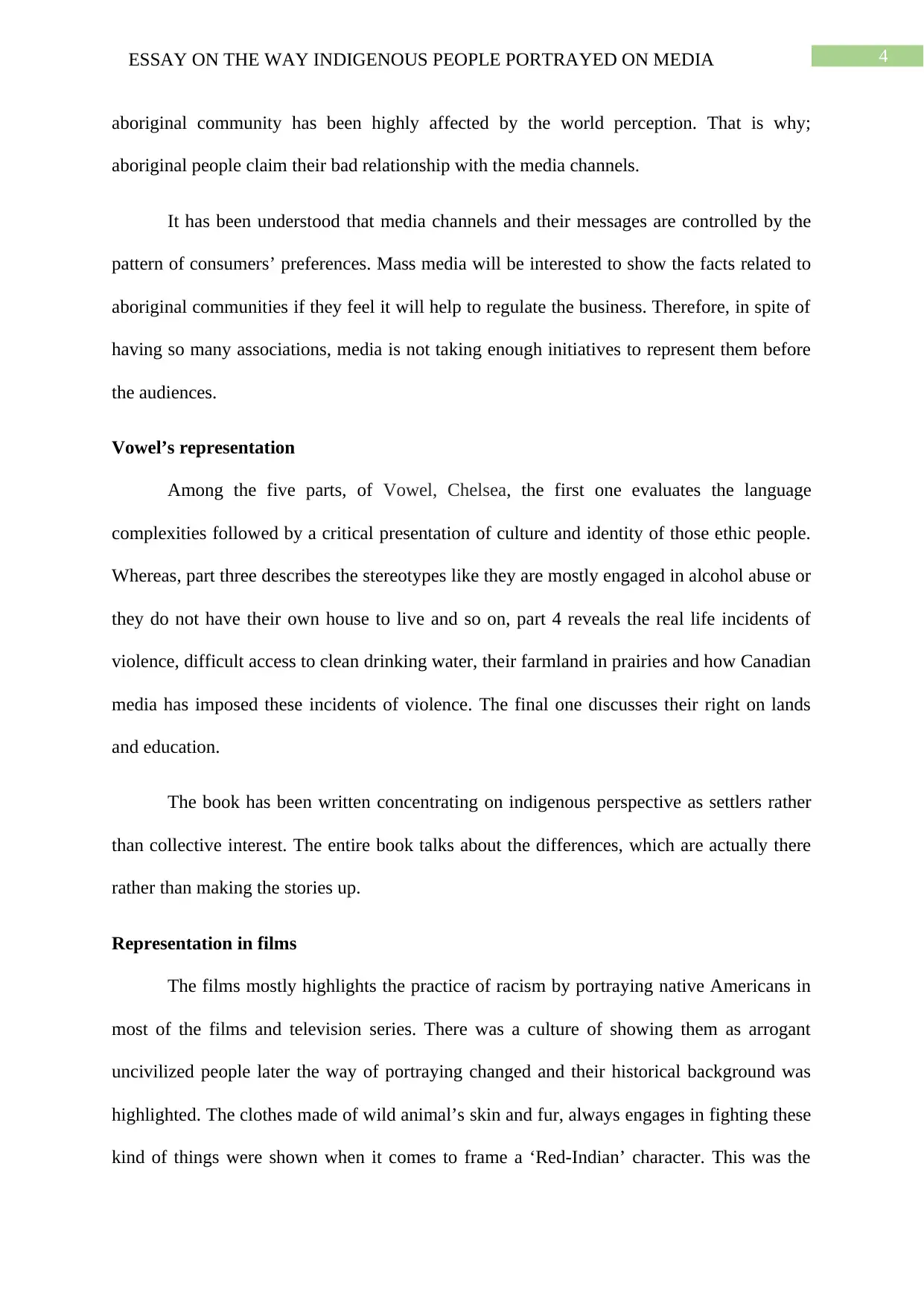
4ESSAY ON THE WAY INDIGENOUS PEOPLE PORTRAYED ON MEDIA
aboriginal community has been highly affected by the world perception. That is why;
aboriginal people claim their bad relationship with the media channels.
It has been understood that media channels and their messages are controlled by the
pattern of consumers’ preferences. Mass media will be interested to show the facts related to
aboriginal communities if they feel it will help to regulate the business. Therefore, in spite of
having so many associations, media is not taking enough initiatives to represent them before
the audiences.
Vowel’s representation
Among the five parts, of Vowel, Chelsea, the first one evaluates the language
complexities followed by a critical presentation of culture and identity of those ethic people.
Whereas, part three describes the stereotypes like they are mostly engaged in alcohol abuse or
they do not have their own house to live and so on, part 4 reveals the real life incidents of
violence, difficult access to clean drinking water, their farmland in prairies and how Canadian
media has imposed these incidents of violence. The final one discusses their right on lands
and education.
The book has been written concentrating on indigenous perspective as settlers rather
than collective interest. The entire book talks about the differences, which are actually there
rather than making the stories up.
Representation in films
The films mostly highlights the practice of racism by portraying native Americans in
most of the films and television series. There was a culture of showing them as arrogant
uncivilized people later the way of portraying changed and their historical background was
highlighted. The clothes made of wild animal’s skin and fur, always engages in fighting these
kind of things were shown when it comes to frame a ‘Red-Indian’ character. This was the
aboriginal community has been highly affected by the world perception. That is why;
aboriginal people claim their bad relationship with the media channels.
It has been understood that media channels and their messages are controlled by the
pattern of consumers’ preferences. Mass media will be interested to show the facts related to
aboriginal communities if they feel it will help to regulate the business. Therefore, in spite of
having so many associations, media is not taking enough initiatives to represent them before
the audiences.
Vowel’s representation
Among the five parts, of Vowel, Chelsea, the first one evaluates the language
complexities followed by a critical presentation of culture and identity of those ethic people.
Whereas, part three describes the stereotypes like they are mostly engaged in alcohol abuse or
they do not have their own house to live and so on, part 4 reveals the real life incidents of
violence, difficult access to clean drinking water, their farmland in prairies and how Canadian
media has imposed these incidents of violence. The final one discusses their right on lands
and education.
The book has been written concentrating on indigenous perspective as settlers rather
than collective interest. The entire book talks about the differences, which are actually there
rather than making the stories up.
Representation in films
The films mostly highlights the practice of racism by portraying native Americans in
most of the films and television series. There was a culture of showing them as arrogant
uncivilized people later the way of portraying changed and their historical background was
highlighted. The clothes made of wild animal’s skin and fur, always engages in fighting these
kind of things were shown when it comes to frame a ‘Red-Indian’ character. This was the
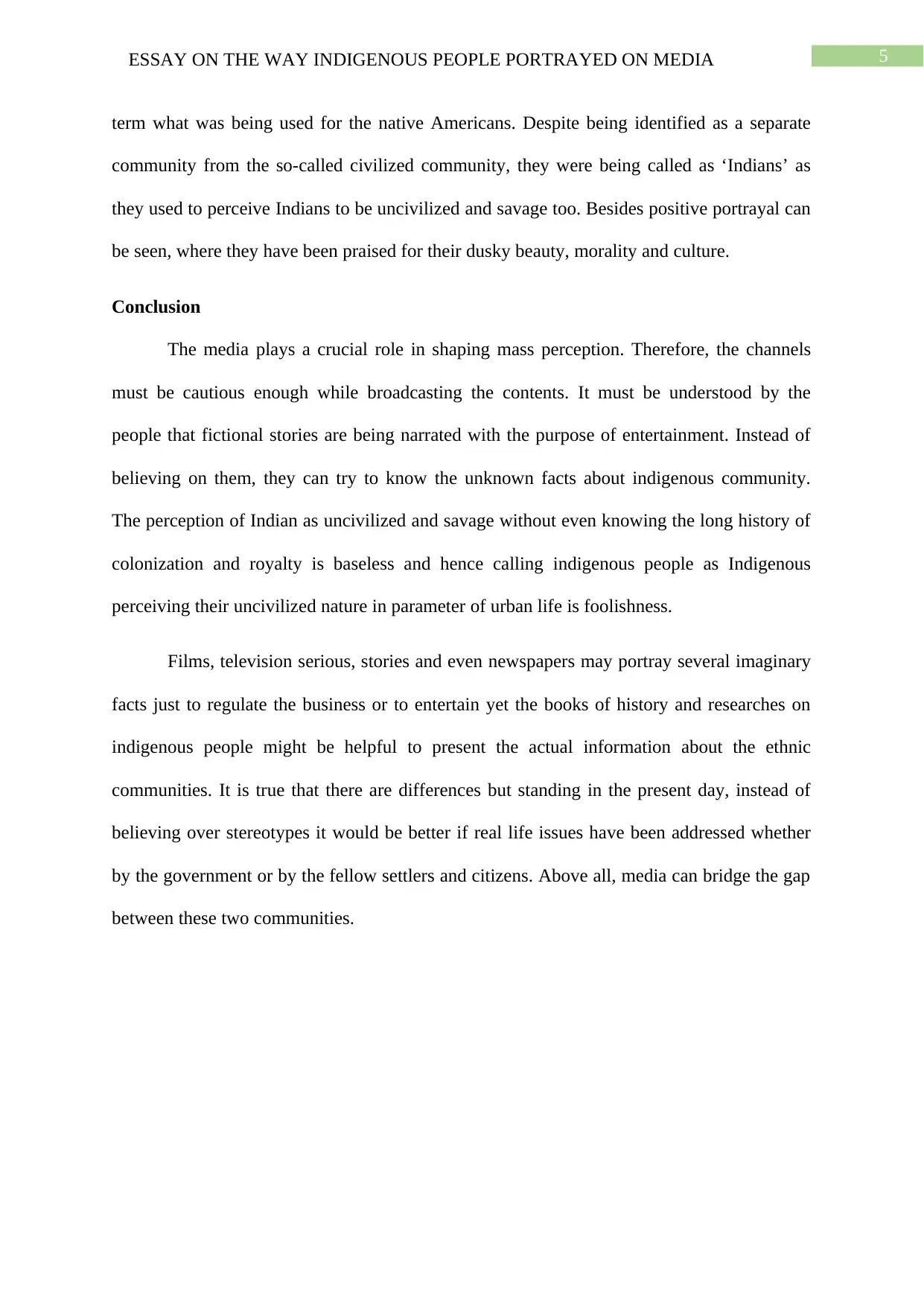
5ESSAY ON THE WAY INDIGENOUS PEOPLE PORTRAYED ON MEDIA
term what was being used for the native Americans. Despite being identified as a separate
community from the so-called civilized community, they were being called as ‘Indians’ as
they used to perceive Indians to be uncivilized and savage too. Besides positive portrayal can
be seen, where they have been praised for their dusky beauty, morality and culture.
Conclusion
The media plays a crucial role in shaping mass perception. Therefore, the channels
must be cautious enough while broadcasting the contents. It must be understood by the
people that fictional stories are being narrated with the purpose of entertainment. Instead of
believing on them, they can try to know the unknown facts about indigenous community.
The perception of Indian as uncivilized and savage without even knowing the long history of
colonization and royalty is baseless and hence calling indigenous people as Indigenous
perceiving their uncivilized nature in parameter of urban life is foolishness.
Films, television serious, stories and even newspapers may portray several imaginary
facts just to regulate the business or to entertain yet the books of history and researches on
indigenous people might be helpful to present the actual information about the ethnic
communities. It is true that there are differences but standing in the present day, instead of
believing over stereotypes it would be better if real life issues have been addressed whether
by the government or by the fellow settlers and citizens. Above all, media can bridge the gap
between these two communities.
term what was being used for the native Americans. Despite being identified as a separate
community from the so-called civilized community, they were being called as ‘Indians’ as
they used to perceive Indians to be uncivilized and savage too. Besides positive portrayal can
be seen, where they have been praised for their dusky beauty, morality and culture.
Conclusion
The media plays a crucial role in shaping mass perception. Therefore, the channels
must be cautious enough while broadcasting the contents. It must be understood by the
people that fictional stories are being narrated with the purpose of entertainment. Instead of
believing on them, they can try to know the unknown facts about indigenous community.
The perception of Indian as uncivilized and savage without even knowing the long history of
colonization and royalty is baseless and hence calling indigenous people as Indigenous
perceiving their uncivilized nature in parameter of urban life is foolishness.
Films, television serious, stories and even newspapers may portray several imaginary
facts just to regulate the business or to entertain yet the books of history and researches on
indigenous people might be helpful to present the actual information about the ethnic
communities. It is true that there are differences but standing in the present day, instead of
believing over stereotypes it would be better if real life issues have been addressed whether
by the government or by the fellow settlers and citizens. Above all, media can bridge the gap
between these two communities.
⊘ This is a preview!⊘
Do you want full access?
Subscribe today to unlock all pages.

Trusted by 1+ million students worldwide
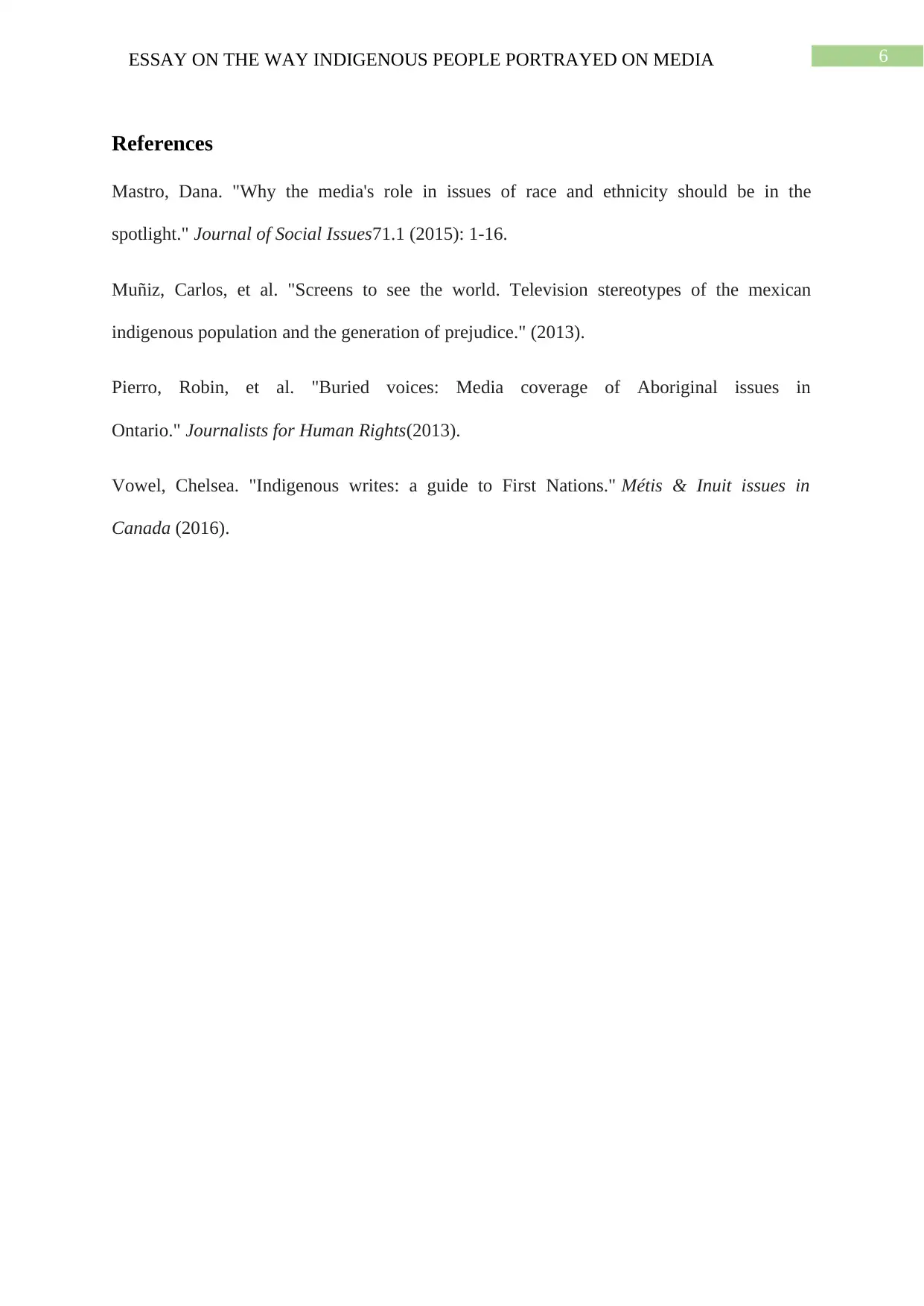
6ESSAY ON THE WAY INDIGENOUS PEOPLE PORTRAYED ON MEDIA
References
Mastro, Dana. "Why the media's role in issues of race and ethnicity should be in the
spotlight." Journal of Social Issues71.1 (2015): 1-16.
Muñiz, Carlos, et al. "Screens to see the world. Television stereotypes of the mexican
indigenous population and the generation of prejudice." (2013).
Pierro, Robin, et al. "Buried voices: Media coverage of Aboriginal issues in
Ontario." Journalists for Human Rights(2013).
Vowel, Chelsea. "Indigenous writes: a guide to First Nations." Métis & Inuit issues in
Canada (2016).
References
Mastro, Dana. "Why the media's role in issues of race and ethnicity should be in the
spotlight." Journal of Social Issues71.1 (2015): 1-16.
Muñiz, Carlos, et al. "Screens to see the world. Television stereotypes of the mexican
indigenous population and the generation of prejudice." (2013).
Pierro, Robin, et al. "Buried voices: Media coverage of Aboriginal issues in
Ontario." Journalists for Human Rights(2013).
Vowel, Chelsea. "Indigenous writes: a guide to First Nations." Métis & Inuit issues in
Canada (2016).
1 out of 7